Key takeaways:
- Pollinator gardens attract essential insects, enhancing local biodiversity and providing emotional rewards through their interaction with nature.
- Key plants for these gardens include bee balm, blue salvia, and native wildflowers, which specifically attract pollinators.
- Proper soil preparation is crucial, involving soil assessment and the addition of organic matter to ensure a healthy planting environment.
- The layout of a pollinator garden should feature a focal point, plant diversity, and tiered arrangements to maximize beauty and accessibility for pollinators.
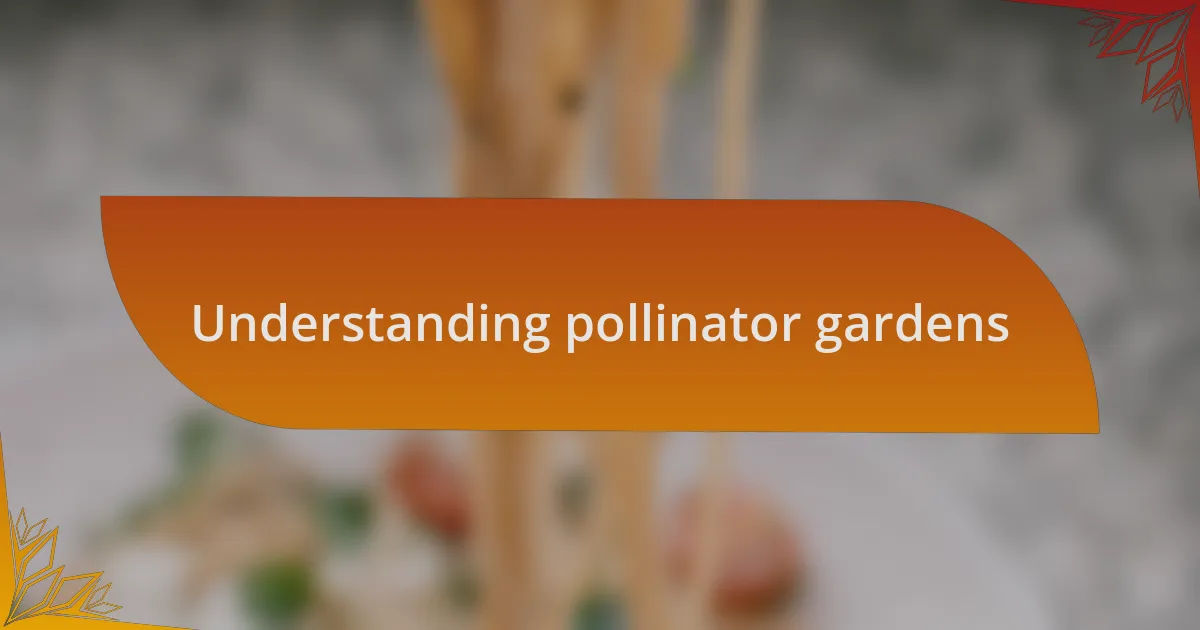
Understanding pollinator gardens
Pollinator gardens are designed to attract and support insects like bees, butterflies, and hummingbirds, which play a crucial role in our ecosystem by helping plants reproduce. I remember the first time I witnessed a swarm of bees buzzing around my garden; it was a moment of pure joy. Seeing them work so diligently felt like an intimate connection to nature.
Creating a pollinator garden involves selecting native plants, as they have adapted to local conditions and provide ample nectar and pollen. I once planted a patch of coneflowers, and the next day, I was stunned to find not only bees but also a flurry of colorful butterflies flitting about. It made me wonder: how much more vibrant our spaces could be if many more people took this initiative?
The emotional reward of nurturing a space that supports life is profound. When I see the little visitors flitting around, it’s almost like they’re thanking me for providing a sanctuary. Have you ever felt that sense of purpose in your gardening efforts? Engaging with these pollinators somehow deepens my appreciation for the natural world, reminding me of our essential role in preserving it.
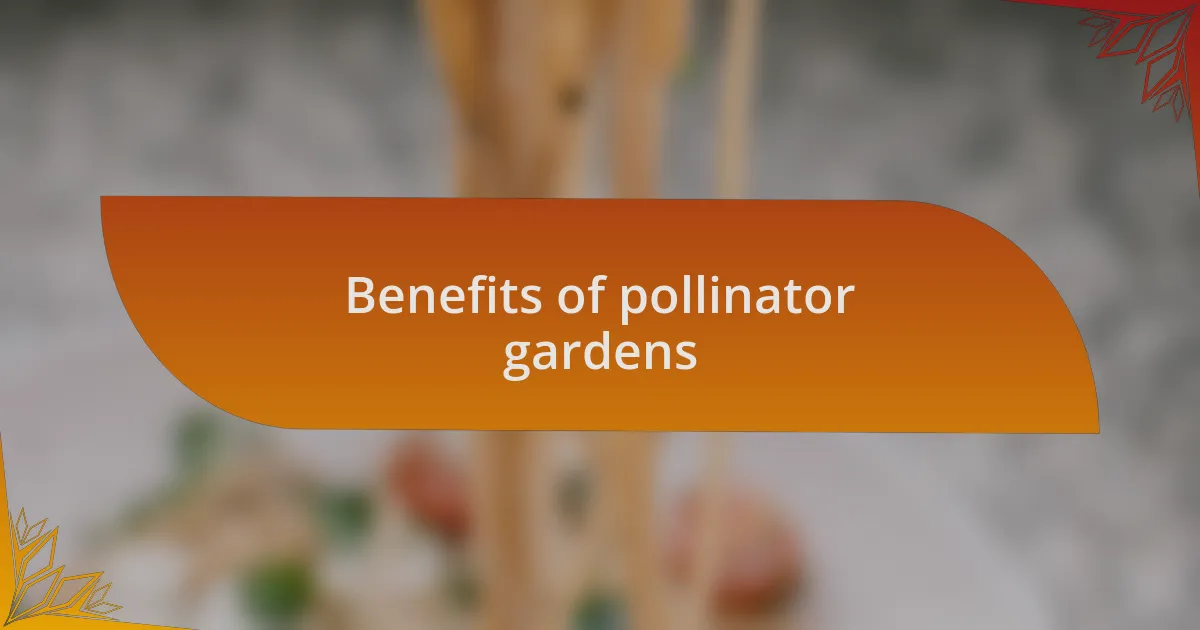
Benefits of pollinator gardens
Pollinator gardens offer a wealth of benefits, both for the environment and our own well-being. When I first noticed the variety of life in my garden, it felt like I had unlocked a hidden treasure. The thrill of watching bees work tirelessly made me realize how crucial these tiny creatures are for our food supply. Have you considered how much we depend on their pollination services for fruits and vegetables? It’s a humbling thought.
Another significant advantage of these gardens is their ability to enhance local biodiversity. I recall one summer when a single planting of milkweed transformed my yard into a vibrant ecosystem, attracting not just pollinators but also other wildlife like birds and even beneficial insects. Observing how life intertwined in that space was like witnessing a delicate dance of nature—each step perfectly in sync.
Additionally, pollinator gardens can serve as an educational platform for our communities. I often invite neighbors to witness the beauty and importance of these gardens. It gives me joy to see their eyes widen as they learn about the species visiting. Have you ever shared the wonders of nature with someone? It’s an experience that fosters not just knowledge but also a sense of community.
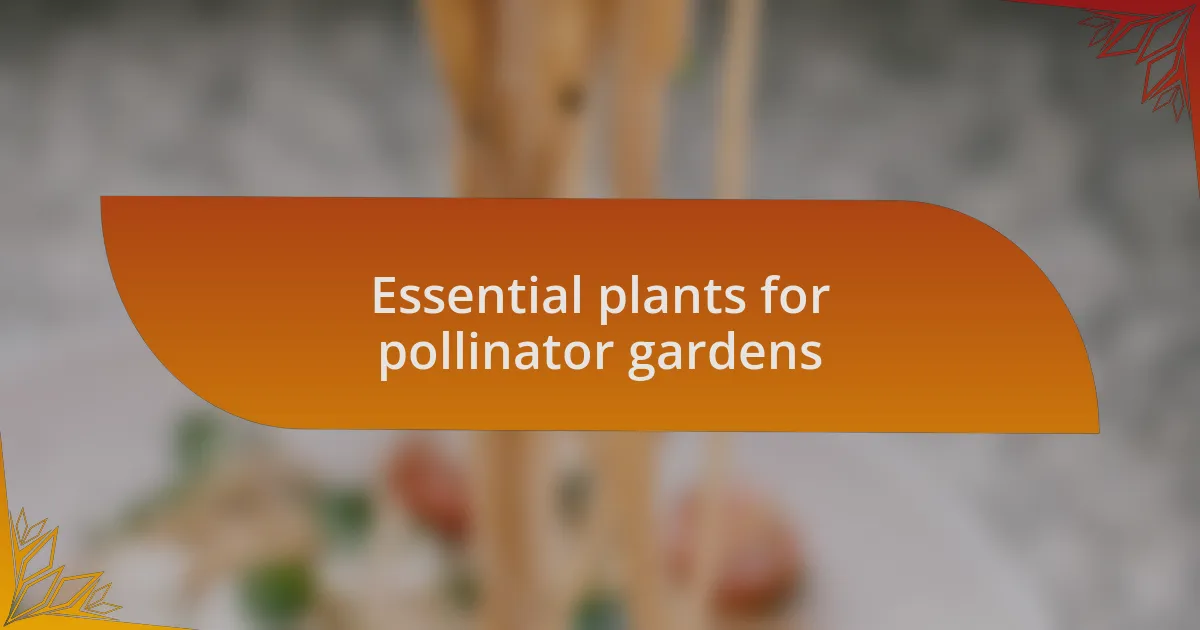
Essential plants for pollinator gardens
One of the essential plants I recommend for pollinator gardens is bee balm. The first time I introduced it to my garden, I was captivated by how quickly it attracted hummingbirds and butterflies. Watching them flit around those vibrant red and pink blooms was like witnessing a living canvas of color and life. Have you ever seen a hummingbird hovering just inches away? It’s a sight that makes you appreciate the little wonders around us.
Another must-have is blue salvia. I vividly remember the day I planted it and later found a swarm of bees reveling in its nectar. The air buzzed with their activity, and I felt like I had created a sanctuary for these small yet vital creatures. Wouldn’t it be gratifying to cultivate a space that not only looks beautiful but also supports our ecosystem? That’s the magic of incorporating plants that specifically draw in pollinators.
Lastly, don’t overlook the power of native wildflowers. I vividly recall the moment when I scattered a mix of them across a sunny patch in my yard. In no time, my garden transformed into a vibrant tapestry, teeming with life. Seeing all those different species visit was like hosting a continuous celebration of nature. What plants do you think would bring that kind of joy to your outdoor space?
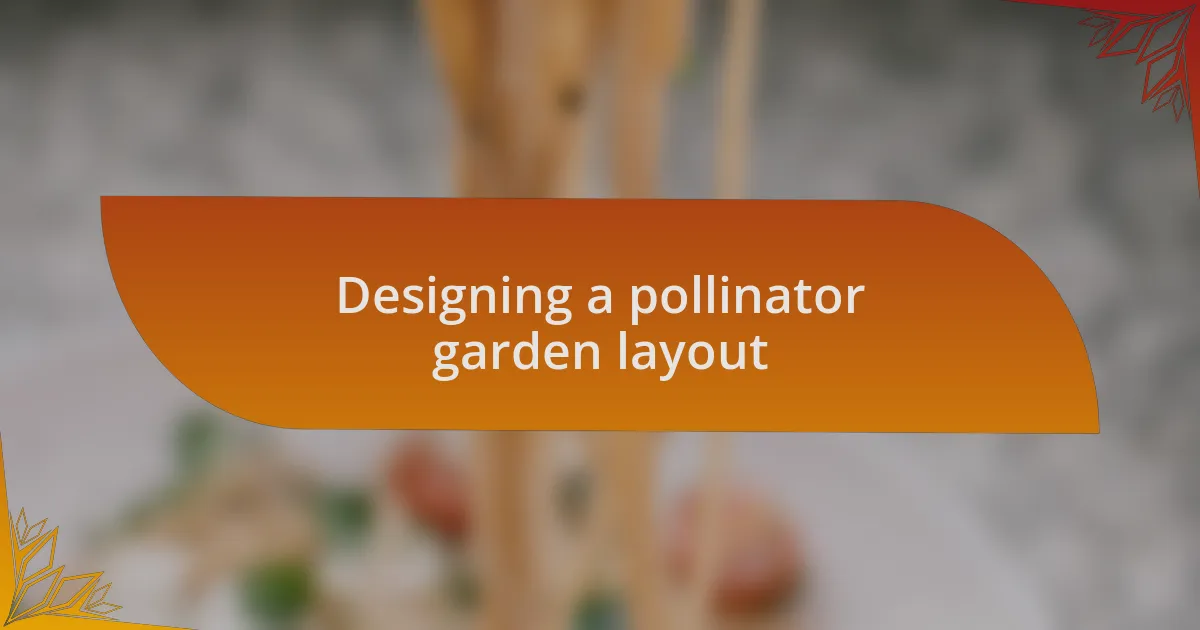
Designing a pollinator garden layout
When planning the layout of a pollinator garden, I suggest starting with a focal point, perhaps a small water feature or a decorative birdbath. I remember how my own garden transformed when I added a vibrant birdbath; it quickly became a hotspot for bees and butterflies, creating a lively atmosphere that was hard to resist. Have you ever considered how a simple element like this could draw in various pollinators and enhance the visual appeal of your garden?
Next, consider the arrangement of your plants. I once experimented with a tiered approach—tall plants in the back, medium in the middle, and shorter varieties in the front. This not only maximized the space but also created a visually pleasing progression that allowed bees and butterflies easy access to the nectar. How could such a layout maximize both beauty and functionality in your own garden?
Don’t forget about plant diversity. My experience has taught me to mix perennial and annual flowers, ensuring blooms throughout different seasons. I vividly recall the thrill of watching diverse species come and go, each contributing to the vibrant micro-ecosystem. What variety of blooms might you include that could sustain these essential visitors all year long?
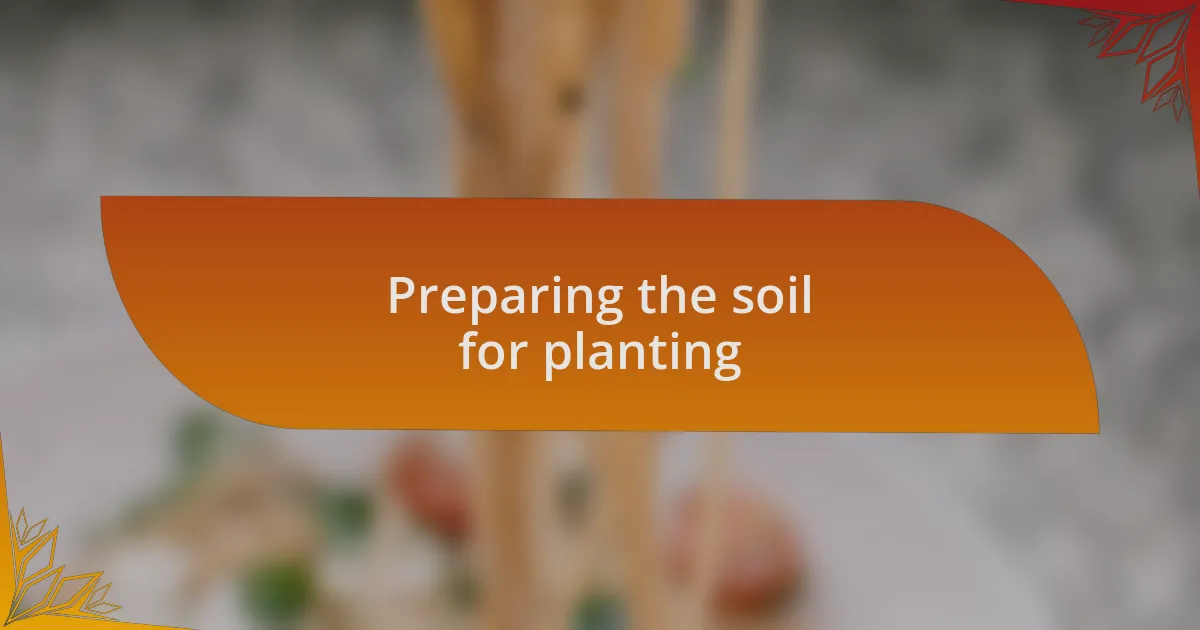
Preparing the soil for planting
Preparing the soil is an essential first step before planting your pollinator garden. After researching soil requirements, I learned how vital it is to assess the quality of your soil. I remember the day I grabbed a handful of dirt from my garden and discovered it was clay-heavy. That realization pushed me to make some necessary amendments for better drainage and aeration, which ultimately led to healthier plants.
To enhance the soil structure, I recommend mixing in organic matter like compost. When I added a generous amount of homemade compost to my garden bed, the transformation was delightful. The soil turned crumbly and rich, providing an inviting environment for plant roots to thrive. Have you considered what type of organic materials you could use to enrich your own soil?
Don’t overlook the importance of pH levels, as they significantly affect nutrient availability. I once had to test my soil’s pH, and it was a bit too acidic for the flowers I wanted to attract. By adding lime, I was able to create a more balanced environment. What steps will you take to ensure your soil is ideally suited for the pollinators you wish to attract?
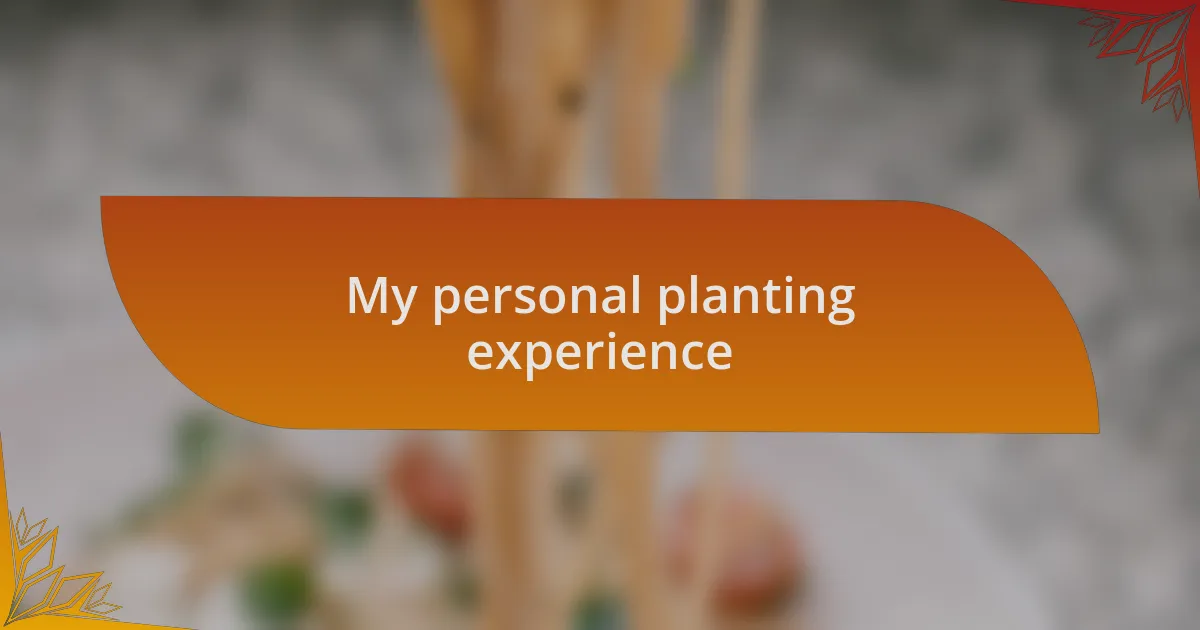
My personal planting experience
When it finally came time to plant, I was flooded with excitement and a hint of anxiety. I vividly recall standing in my garden, surrounded by tiny seedlings, each representing my hopes for attracting bees and butterflies. I carefully spaced them according to their height and sun requirements, envisioning the vibrant colors and fluttering wings that would soon grace my garden. Have you ever felt that mix of anticipation and fear when starting something new?
As I gently nestled each plant into the soil, I was struck by the intimacy of the act. I felt a deep connection with nature, almost as if I was nurturing old friends. The scent of fresh soil filled the air, and with every seedling I planted, I whispered a small wish for them to thrive. This ritual of planting not only fed my garden but also nourished my soul. What do you find most fulfilling about the act of planting?
Once the plants were established, witnessing the busy pollinators transform my space was truly magical. I remember sitting quietly, watching a bumblebee hover around the blooms I’d planted. It filled me with joy, knowing my efforts were paying off as my garden became a thriving habitat. Those moments of connection with the pollinators made all the hard work worth it. Have you considered how your own garden could become a haven for these incredible creatures?